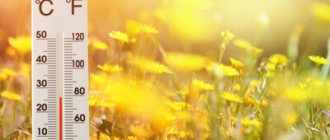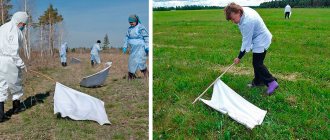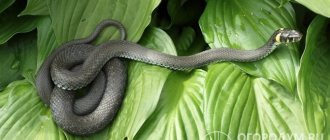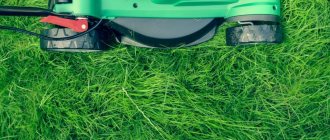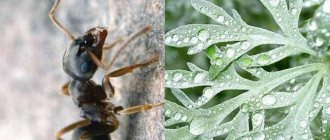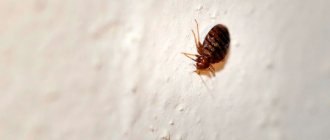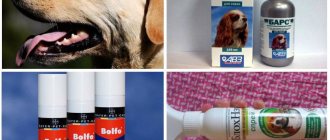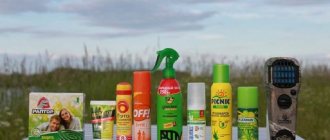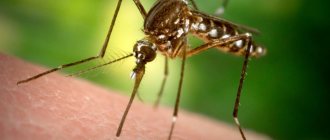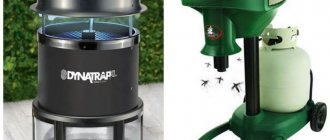all sorts of inconveniences associated with mosquitoes immediately begin Not only do they carry out their raids even in dry places, but where there are people and do not live in their usual humid environment, they also prevent people from sleeping with their buzzing. But the biggest danger that can happen is infection with some kind of infection that enters the body through a bite or an allergic reaction. It’s not always possible to track whether a malaria mosquito bit you or a simple one.
- Treatment of mosquitoes in a garden, country or household plot
- TOP 5 mosquito repellents Tsifoks
- Medilis cyper
- SIPAZ SUPER
- Agran
- Sinuzan
Various insecticidal agents can help you get rid of annoying blood-sucking insects , the correct choice of which is the key to the success of any pest control operation. Of course, it’s best when professionals get down to business. Those specialists who are trained to select the necessary dosages of drugs against blood-sucking insects. They also know techniques and methods on how to save an area from bloodsuckers in one session with maximum coverage of areas.
Why fight mosquitoes in your summer cottage?
You can talk as much as you like about the role of mosquitoes in the ecological system and about their indispensability in natural processes, but if you or your child is allergic to mosquito bites, then you want the bloodsuckers to perform their irreplaceable role away from the dacha or country house.
Mosquito saliva causes itching, swelling and redness at the site of the bite, and in some cases an allergic reaction.
It is known that mosquitoes are capable of transmitting dangerous diseases such as malaria or encephalitis. The cases are quite rare, but they do occur. This is enough to start exterminating these insects on your site.
Infections carried by mosquitoes are transmitted through saliva during a bite.
Methods of combating flying bloodsuckers can be divided into chemical and folk. When choosing a method, you need to take into account that chemicals have all the pros and cons of modern insecticidal preparations. Folk remedies, for all their environmental friendliness, cope with the task less effectively.
To better make a choice, it’s worth taking a closer look at what the modern market of anti-mosquito drugs offers us and how people’s experience has expanded over time.
TOP 5 mosquito repellents
There are 3 of the most effective and popular insecticides today that will cope with insects in your dacha, backyard or garden. These are Cifox, Medilis Cyper and Bioneutral I50. You may not hear about these drugs in commercials on TV, but specialists often use them .
Cifox
A professional product to combat mosquitoes and other blood-sucking parasites such as bedbugs or cockroaches.
- 25% solution of such a powerful insecticide as cypermethrin. Usually, these percentages also contain all kinds of fragrances, emulsifiers and solvents. Therefore, disinfection specialists can call this drug an emulsion.
- The liquid is transparent with a yellowish tint and a sharp, specific odor .
- The capacity is usually 500 ml or 1 liter. Available in bottles or canisters, depending on volume.
- Tsifoks is used as follows. The solution is prepared strictly according to the instructions, from 4 ml of product per 1 liter of water. Solution consumption - 1 liter per 1 hundred square meters
- The average cost of a 500 ml bottle is 900 rubles.
BUY
Medilis cyper
The domestically produced insecticide “Medilis ziper” is capable of destroying mosquitoes not only in areas such as open areas of residential buildings, but even inside premises such as apartments, hotels, campsites, etc.
- The composition includes the same 25% cypermethrin as the previous drug.
- The liquid has a transparent yellowish color, is toxic, and has a milky color when dissolved.
- Distributed in bottles of 50 or 500 ml, as well as in 5 liter canisters.
- Preparation of the solution: from 2 to 5 ml per 1 liter of water, depending on the density of vegetation.
- Consumption: 1 liter of working solution per hundred square meters
- The cost of the drug with a volume of 500 ml is about 1,534 rubles.
BUY
SIPAZ SUPER
- Country of origin: Russia .
- Available in the form of a concentrate.
- Capacity volume – 1 l.
- Preparation of the solution: from 3 to 8 ml of product per 1 liter of water . 1 acre requires 1 liter of working solution
- Method of application - spraying the product in calm weather over bushes, thick grass and lower branches of trees, as well as near children's play areas - sandboxes, swings, hammocks, flower beds, lawns, etc.
- Active ingredient – cypermethrin 25%
- The drug is suitable for use for 3 years from the date of manufacture.
- The average cost is 2250 rubles.
BUY
Warning: treatment with this product must be carried out in the evening , when bees are no longer flying . The effect of the drug on plants does not have any harmful effects; therefore, it will not harm a honey bee if it lands on a flower in the morning where microdrops of the insecticide have landed. It is also very important to look at the season - as soon as mosquitoes wake up, it is better to treat the area. As a rule, they begin to bother you before the bees begin to actively collect nectar.
Agran
The substance is diluted with water according to the instructions and sprayed through a spray bottle wherever there is water or a constant damp environment.
- Excellent for those dacha areas that are located near the water , or where there is groundwater close to the surface of the earth. All trolleys, barrels, ditches, drainage pits are also treated
- Active ingredient: Chlorpyrifos 50%, Cypermethrin 5%
- for mosquitoes 2.75 g/l, working solution consumption 50-100 ml/m. sq., when treating reservoirs 100 ml/m. sq.
- The average price is 1,700 rubles .
BUY
Sinuzan
- Active ingredient: chlorpyrifos 48%
- Preparation of the solution: from 2 to 5 ml of the drug per 1 liter of water. The solution consumption is approximately 100 ml per 1 sq.m.
- Cost - 2000 rubles
BUY
Photo gallery: measures to prevent the appearance of mosquitoes in a summer cottage
Water containers on the site must be tightly closed (it must be changed at least once a week)
When watering, do not over-moisten the soil and allow puddles to form.
There is no need to allow overly lush vegetation and weeds to grow on the site.
Danger of mosquitoes
The presence of large concentrations of mosquitoes in the area is mainly dangerous due to painful bites and allergies. For many people, the reaction manifests itself as eczema or hives. The allergy is caused by saliva, which the insect injects during a bite to prevent blood clotting. People who are sensitive to this experience severe redness and irritation.
Mosquito bites are dangerous because insects can carry diseases: meningitis, Japanese encephalitis, etc. Therefore, it is better not to postpone the fight against them.
Mosquito larvae appear and develop in stagnant water. At dachas, insects choose large puddles, gutters, rain barrels, drinking containers for pets, etc. for breeding. There are such potentially dangerous places in many areas; getting rid of them is problematic, but mosquito control can be carried out periodically.
Why larvicidal treatment cannot be carried out independently
Many people believe that it is possible to process a swampy area on their own, but experts strongly do not recommend doing this for several reasons:
- larvicides pose a certain danger to humans, because without covering clothing and personal protective equipment, active compounds can damage the mucous membrane of the eyes, damage the skin or cause poisoning;
- An incorrectly calculated dose of the active drug is fraught with disruption of the natural microclimate of the area. Due to exceeding the permissible % of larvicides, the fish in the reservoir may die or the water will become unsuitable for plant growth;
- Without preparation and skills, it is very difficult to carry out high-quality treatment of the area; to spray the product you will need a special one. equipment, and processing the surrounding area often requires additional operations.
flies
These winged creatures are more likely to irritate a person with their intrusive attention than with their sabotage. Still, flies are not safe.
Benefit
Unfortunately, flies currently provide the same benefit as mosquitoes: they are excellent food for some other fauna. However, Russian scientists are considering the possibility of processing environmentally hazardous waste from livestock farms and poultry farms with fly larvae. Whether they succeed or not, we will soon find out.
Harm
We can talk about the dangers of flies endlessly. These representatives of the class of insects not only “help” us eat food, but due to the fact that they are ubiquitous, they carry a wide range of different pathogenic microbes and parasitic worms. That's it in a nutshell.
Fly repellents
In an effort to get rid of these annoying creatures, people showed imagination that knew no bounds. As a result, both numerous chemical means of control (Dichlorvos, Chlorophos, Tsifoks, Mukhoyar, Mashenka, Muskachid, Fly Byte, Karakurt) and traditional methods of their destruction (wiping objects loved by flies with a solution of 2-3 tablespoons of vinegar and 1 l of water, hanging bunches of tansy and wormwood from the ceiling and laying out slices of lemon with clove sticks on the tables). Adhesive tapes attached to chandeliers are no less effective. And residents of some villages, out of old memory, still use fly swatters: they are effective, inexpensive, and if successfully hit, they extremely quickly relieve irritation.
- House flies - why they are dangerous to humans and how to get rid of them
We offer proven means of controlling flies. We also tell you how to make a cool trap from an ordinary bottle!
Flies also do not like plants such as basil, lavender, bay leaves, mint, tansy, rosemary and garden geranium.
Repellents
Smells play a huge role in the life of insects, helping them accurately find food and avoid danger. Thus, they detect people and animals by the smell of the sweat they secrete, which unmistakably signals the female bloodsuckers about the presence of tasty fresh food. Consequently, by masking our own smell with some strong aroma, we send a message to the small vile: fly away from here, there is nothing interesting for you here.
Attention! In order for the disguise to work without failure, before using fragrances you need to thoroughly wash your body, removing traces of previously released sweat. For some insects, just one molecule per cubic meter of air is enough to detect food.
Folk remedies for repelling midges and mosquitoes
You will find most of the repellents in this group in your own kitchen, in the first aid kit or in the nearest forest.
- Sagebrush. To prepare an anti-mosquito tincture, collect the roots of fresh wormwood and chop finely, then pour boiling water over it and leave for half an hour. For a glass of chopped wormwood roots you need to take a liter of water. When the broth has cooled, apply it with a cotton swab or spray bottle to open areas of skin, spray door and window openings.
- Camphor. In any pharmacy you will find camphor alcohol, tincture or crystalline camphor. As dusk sets in and mosquitoes become more active, pour camphor from the vial into a small saucepan, place on the stove and evaporate the substance by heating over low heat. After this procedure, you are guaranteed a restful sleep throughout the night. If you pour the solution into a tin can and evaporate it over a fire or barbecue, then during the evening not a single mosquito will come close to the area where you are resting.
- Valerian. In the same way, valerian tincture is used, which has similar properties. True, in this case, a side effect is possible in the form of an invasion of cats in the summer cottage.
- Aroma oils. As practice shows, bloodsuckers cannot tolerate the smell of cedar, tea tree, basil, eucalyptus, clove, and anise oils. Evaporate a few drops of any of these oils in an aroma lamp to cleanse a room, veranda or gazebo. Mix the aroma oil with any cream and lubricate exposed skin.
- Vanillin. To effectively protect the skin, two or three packets of vanillin should be mixed with the cream until completely dissolved, and then applied to the face, arms and legs. You can dissolve the substance in water, vodka or alcohol and spray it on the skin and furniture.
Products applied to the skin do not last long. For them to work well, it is necessary to renew the protective coating every 1-2 hours.
Chemical repellents
A wide selection of mosquito repellents can be easily found in the specialized section of any supermarket. Repellents in the form of a cream or spray are applied to the skin for personal protection. The rules are, in general, the same as when using folk remedies: they need to be applied to cleanly washed skin and updated periodically. Unfortunately, they are not suitable for use at night: you will fall asleep peacefully without hearing the irritating mosquito ringing, but after a couple of hours the effect of the repellent will stop, and the bloodsuckers will attack your defenseless skin.
Electronic repellers
The action of a small but very effective device is based on the emission of ultrasonic waves in the range from 5 to 20 KHz. Most models operate on a 220 V network. There are also battery-powered mobile devices, but their power is usually low, so the range does not exceed 2.5 meters. The capabilities of network repellers are significantly higher: one device is enough to secure a country house, an open veranda or a spacious gazebo.
Insect repeller ENERGY 6W ultrasonic
Why treat ponds from insects?
There are several reasons to treat ponds, flooded areas of the yard and waterlogged basements of houses from insects:
- the procedure allows you to significantly reduce the number of dangerous bloodsuckers in the treated area, since during the treatment of the area, in addition to adult individuals, larvae die, and the development of laid eggs slows down;
- the operation minimizes the risk of infection due to insect bites; the fewer blood-sucking flying individuals, the less likely it is to be bitten;
- active preparations used during processing act as disinfectants, eliminating not only insects, but also dangerous viruses and microorganisms.
Traps
Such devices are made by hand and are very effective and safe.
From the bottle
To make a trap, the following components are required:
- plastic bottle with a volume of 1–1.5 l;
- 5 g yeast;
- 50 g sugar;
- stapler, tape or any other suitable fixing object;
- stationery knife or scissors;
- black thick fabric;
- 200 ml water.
Sequence of assembly of the device:
- 1. The top of the bottle is cut off by about a third.
- 2. Add sugar, yeast and water to the remaining portion.
- 3. The resulting solution is thoroughly mixed (the water temperature should not exceed +40 ° C, otherwise the yeast will die prematurely, without having time to ferment).
- 4. An inverted neck is inserted into the bottle scrap from above so as to form a funnel.
- 5. The structure is wrapped in black fabric to intensify the fermentation process and fixed with tape in places where mosquitoes accumulate.
- 6. Insects will fly into the bottle towards the smell that attracts them, but will not be able to get back out.
In these proportions of yeast and sugar, the trap lasts for about a week, after which it is replaced with a new one or the used ingredients are added. You should not keep the bottle in direct sunlight so as not to damage the design.
From vegetable oil
Such a trap is simple and, if you have the necessary items, can be prepared in a matter of minutes. For production you need:
- 4 tablespoons of vegetable oil;
- 3-4 plastic bottles;
- scissors.
Algorithm for creating a device:
- 1. The top parts of the bottles are removed just below the neck.
- 2. Large parts of the bottles are carefully treated from the inside with oil.
- 3. The finished trap is placed in a place where mosquitoes accumulate.
What to do with mosquito larvae in a garden pond?
You can also use BTI here as organic measures are safe for humans and animals will be followed. An often overlooked tip is to apply a cinnamon oil solution (15% cinnamon oil with 85% water). Cinnamon aldehyde, cinnamon acetate, eugenol and anethole are the four main components of cinnamon oil that kill mosquito larvae in the pond. The benefit of this option is that you can enjoy the sweet and tasty smell of the solution while effectively eliminating pests in a nearby pond or lake.
Spring Solstice (March 21): In the old days, people took knives to drive away troubles
The animated series "Peppa Pig" will last until 2027, 104 new episodes will be filmed
To eliminate “gray” SIM cards, Roskomnadzor wants to know who Russians are calling
In addition to the above methods, there are other highly effective remedies for mosquito larvae. They can act naturally or chemically.
Prevention of pest control
The most important thing is not to give midges a single chance to survive. Having eliminated the source of the midges, after some time the insects will disappear on their own. All products present at the dacha must be stored either in the refrigerator or in the cellar. To avoid the appearance of midges in the compost heap, you need to treat it using antiseptic agents. And the table and floors, both in the house and in the summer kitchen, should be thoroughly washed, especially after canning.
Folk remedies – will they help replace specialized chemicals?
To achieve maximum efficiency, it is necessary to carry out comprehensive work on treating the area from insects. In the case of alternate use of chemicals or specialized devices, the fight against bloodsuckers may drag on for a long period of time, and it will be more difficult to deal with them in the future.
Many experienced summer residents prefer the use of folk remedies that provide a passive type of protection for the local area. To do this, they plant plants that have an unpleasant aroma that repels bloodsuckers.
This option involves planting the following plants:
- Tomatoes. It is best to plant tomato bushes along the window or along the entire perimeter of the territory. The aroma that such a plant exudes is poorly tolerated by insects. Thanks to this simple method, you can reduce pest activity. This technique can also be used by apartment owners, since tomato bushes can be placed on the windowsill.
- Wormwood, tansy. When choosing plants that will be used to repel mosquitoes in a country house or on the territory of a country house or garden plot, you can plant medicinal herbs. They will not only repel mosquitoes and some other pests with their rich smell, but will also become an excellent assistant for certain types of diseases.
- Mint, lemon balm. Different types of mint are effective plants in the fight against mosquitoes and midges. To get the maximum result, you should not only plant such vegetation on the territory, but dry the mint, spread it around the perimeter of the entire house, and also throw it on the fire - an excellent effect is achieved when burning.
Despite the fact that folk remedies help in independently cleansing a summer cottage from midges, blood-sucking insects, you need to understand that this is only a short-term effect. Fighting mosquitoes with the help of vegetation, flowers and herbs can take a long time, and in the end, completely getting rid of them will be impossible.
